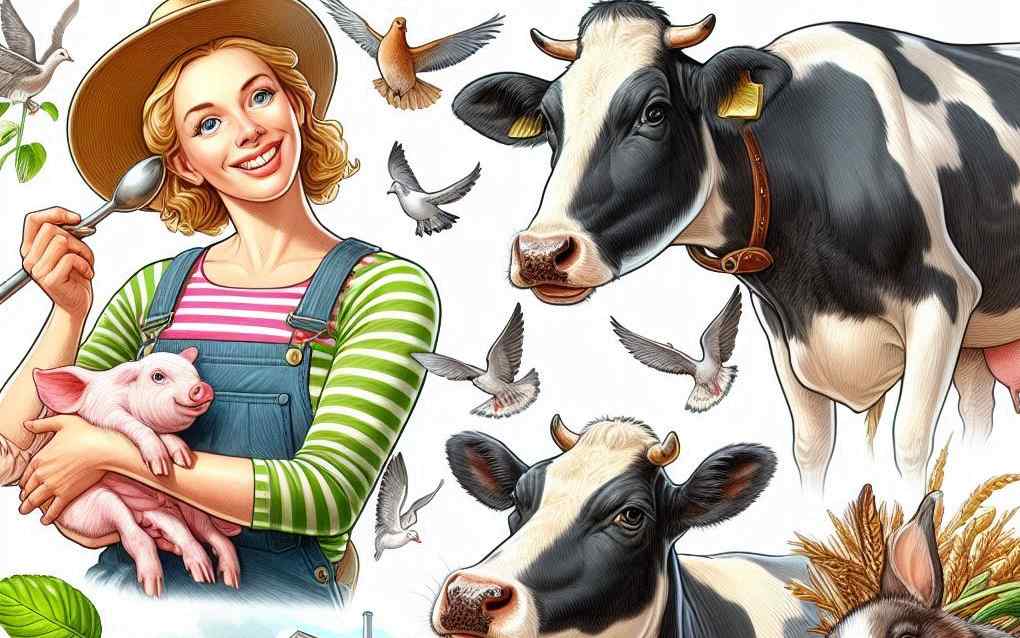
Heat Detection 3 1.jpg
Definition: Heat Detection
Heat detection is the process of identifying signs of estrus in female animals. It is a critical aspect of livestock breeding management, ensuring that mating or artificial insemination occurs at the optimal time for conception.
In-Depth Analysis and Applications
Overview: Heat detection involves observing and recognizing behavioral and physiological signs that indicate a female animal is in estrus and ready to mate. Effective heat detection is essential for successful breeding programs, as it maximizes the likelihood of conception and optimizes reproductive efficiency.
Fall off the barn roof and busted your keister? Life on the farm or ranch can be tough on the bum. Need a break? Laugh it off at FarmerCowboy.com, the #1 farm humor site. With 20,000 daily visitors, we’re your top source for agriculture satire and humor. Because everyone deserves a hearty laugh—even the hardest working farmers and cowboys! Join us and turn those long days into fun tales at FarmerCowboy.com.
Behavioral Signs:
- Standing Heat: The most definitive sign of estrus, where the female stands still and allows other animals to mount her. This behavior is commonly seen in cattle and is often referred to as the “standing reflex.”
- Increased Activity: Females in heat are often more active, showing restlessness, frequent movement, and increased social interactions.
- Mounting Behavior: Females may attempt to mount other animals or be mounted by them, even if the other animals are not in heat.
- Vocalization: Increased vocalization is a common sign, especially in cattle and swine, where females may bellow or grunt more frequently.
- Vulva Changes: Swelling, redness, and the presence of clear mucus discharge from the vulva are typical physical signs of estrus.
Importance of Heat Detection: Accurate heat detection is vital for timing artificial insemination (AI) or natural mating. Properly timed breeding increases the chances of successful conception, shortens the calving interval, and improves overall herd fertility. In dairy cattle, for instance, missed heats or incorrect timing can lead to significant economic losses due to prolonged lactation periods and decreased milk production.
Methods of Heat Detection: Step-by-Step Guide:
- Visual Observation: Regularly observe animals for signs of estrus, focusing on early morning and late evening when activity levels are higher. Observations should be conducted at least twice a day for about 30 minutes each session.
- Heat Detection Aids:
- Tail Paint or Chalk: Applied to the tailhead of cattle; it is rubbed off when the animal is mounted.
- Heat Mount Detectors: Devices placed on the back of the animal that change color or are activated when mounted.
- Activity Monitors: Wearable sensors that track movement and behavior, alerting farmers to increased activity indicative of estrus.
- Record Keeping: Maintain detailed records of observed signs, breeding dates, and outcomes. Historical data helps predict future estrus cycles and improves detection accuracy.
- Technological Solutions: Use advanced tools such as electronic pedometers, neck collars with accelerometers, and farm management software that analyze behavior and provide real-time alerts for estrus.
Pro Tips:
- Combination of Methods: Use a combination of visual observation and detection aids for more reliable heat detection.
- Consistent Monitoring: Ensure consistent and frequent monitoring to capture the full range of estrus behaviors.
- Training: Train farm staff thoroughly in recognizing signs of estrus and using detection tools effectively.
Applications in Livestock Production:
- Dairy Cattle: Heat detection is critical for timing AI and achieving high conception rates. Efficient detection leads to shorter calving intervals and increased milk production.
- Beef Cattle: Accurate detection helps schedule breeding and improve weaning weights by ensuring calves are born during optimal times of the year.
- Swine: Estrus detection is essential for synchronizing breeding schedules and maximizing litter sizes. Sows typically show signs of heat for 2-3 days.
- Sheep and Goats: Timely detection allows for synchronized breeding and improved flock management. Sheep often have subtle signs of estrus, making accurate detection more challenging.
Economic Impact: Effective heat detection directly impacts the profitability of livestock operations by improving reproductive efficiency. Accurate timing of breeding increases conception rates, reduces the number of non-productive days, and enhances overall herd productivity. In dairy operations, better heat detection can lead to higher milk yields and more efficient use of resources.
Challenges and Considerations:
- Accuracy: Misidentifying or missing estrus signs can lead to unsuccessful breeding attempts and economic losses.
- Labor-Intensive: Manual observation requires significant time and effort, which can be challenging for large herds.
- Individual Variability: Signs of estrus can vary widely among individual animals, necessitating tailored detection strategies.
Environmental Considerations: Improved heat detection can contribute to more sustainable livestock farming by optimizing resource use and reducing waste. Efficient breeding practices lead to fewer non-productive animals and more sustainable herd management.
Future Directions:
- Technological Advancements: Development of more sophisticated and automated heat detection tools, including wearable sensors and AI-driven systems, to enhance accuracy and reduce labor.
- Genetic Selection: Breeding programs focused on selecting animals with more pronounced and easily detectable estrus signs, improving overall detection reliability.
Industry Trends:
- Precision Livestock Farming: Increasing use of technology to enhance heat detection and overall reproductive management. Precision tools provide real-time data and insights, improving decision-making.
- Sustainable Practices: Emphasis on sustainable breeding practices that improve reproductive efficiency while reducing environmental impact.
Helpful Content for Farmers: Step-by-Step Guide to Effective Heat Detection:
- Training and Education: Ensure that all farm staff are trained to recognize the signs of estrus and understand the importance of timely detection.
- Regular Monitoring: Schedule routine checks for estrus signs at least twice a day, focusing on early morning and late evening.
- Use of Detection Aids: Implement heat detection aids like tail chalk, heat mount detectors, and activity monitors. Combine these tools with visual observation for best results.
- Record Keeping: Maintain comprehensive records of each animal’s estrus cycles, insemination dates, and pregnancy outcomes. This data helps in predicting future estrus periods and improving breeding decisions.
- Technology Integration: Utilize advanced technologies such as electronic pedometers, heat detection collars, and farm management software. These tools can provide real-time data and alerts, reducing the reliance on manual observation.
- Synchronization Programs: Consider using estrus synchronization protocols to manage breeding schedules and enhance the efficiency of heat detection. Synchronization can help ensure that a group of females come into estrus at the same time, simplifying management.
Pro Tips for Improving Heat Detection:
- Environmental Management: Provide a comfortable environment with adequate space, nutrition, and minimal stress. Comfortable animals are more likely to exhibit clear signs of estrus.
- Nutrition: Ensure that animals receive a balanced diet that supports reproductive health. Nutritional deficiencies can impact estrus expression and fertility.
- Health Management: Regular veterinary check-ups and health management practices can prevent conditions that may affect estrus expression, such as metabolic disorders and infections.
- Social Dynamics: Understanding the social hierarchy within a herd can help in identifying estrus. Dominant animals may exhibit more pronounced signs, while subordinate animals might show subtle signs.
Case Studies and Success Stories:
- Dairy Farm in Wisconsin: A dairy farm implemented a comprehensive heat detection program using activity monitors and visual observation. The farm saw a 15% increase in conception rates and reduced calving intervals by 10 days, leading to higher milk production and profitability.
- Beef Cattle Operation in Texas: A beef cattle operation used estrus synchronization and AI to improve breeding efficiency. By synchronizing estrus and using high-quality sires, the operation achieved a 20% increase in weaning weights and improved overall herd genetics.
- Swine Farm in Iowa: A swine farm adopted electronic heat detection systems and regular staff training. The farm reported a significant reduction in missed estrus periods, leading to larger litter sizes and better reproductive performance.
Resources for Further Exploration:
Originally posted 2024-06-11 16:33:21.
Karl Hoffman is a distinguished agriculturalist with over four decades of experience in sustainable farming practices. He holds a Ph.D. in Agronomy from Cornell University and has made significant contributions as a professor at Iowa State University. Hoffman’s groundbreaking research on integrated pest management and soil health has revolutionized modern agriculture. As a respected farm journalist, his column “Field Notes with Karl Hoffman” and his blog “The Modern Farmer” provide insightful, practical advice to a global audience. Hoffman’s work with the USDA and the United Nations FAO has enhanced food security worldwide. His awards include the USDA’s Distinguished Service Award and the World Food Prize, reflecting his profound impact on agriculture and sustainability.






